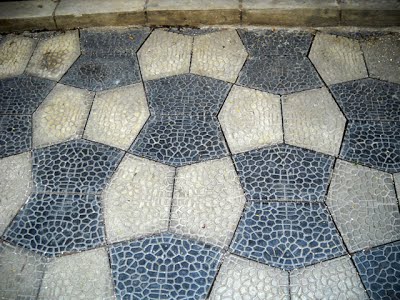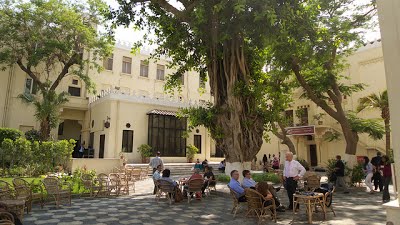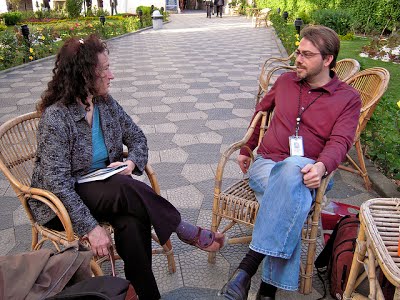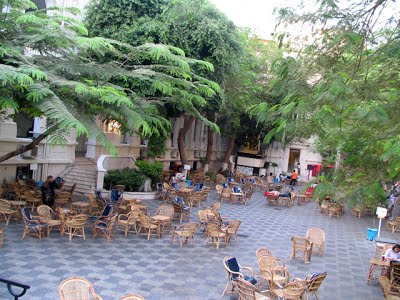On occasion, some of the sightings of the pavings are more notable than others as regards their history, location, and extent, of which these instances being of importance/substance than of ‘general street sightings’ as discussed in ‘pictures of sightings 1 and 2’, are thus discussed in more detail aside from such instances. These specific instances include the American University in Cairo (AUC) (and the Old Cataract Hotel, in Aswan), the subject of the discussion here. To begin, some background detail as to the AUC. Note that some of this page overlaps with the first photographs page, this also concerning the AUC.
History The American University in Cairo was founded in 1919 by Americans devoted to education and service in the Middle East. For its first 27 years the university was shaped by its founding president, Dr. Charles A. Watson. He wanted to create an English-language university based on high standards of conduct and scholarship and to contribute to intellectual growth, discipline, and character of the future leaders of Egypt and the region. He also believed that such a university would greatly improve America’s understanding of the area.
Campus The American University in Cairo is located on Tahrir Square in downtown Cairo, near government ministry buildings, hotels and commercial areas, the National Cultural Center, and the Egyptian Museum. The campus covers parts of five city blocks. Gracefully situated on the main campus are a converted palace, outdoor basketball and tennis courts, gardens, and a fountain area. The original university building, which opened in 1920, was constructed as a palace in the 1860s for the Minister of Education Khairy Pasha. The building briefly became the headquarters of the Egyptian University (now Cairo University) in the early 1900s and was acquired by AUC in 1919. The palace now houses central administrative and faculty offices and a number of classrooms. Additions constructed on the main campus between 1927 and 1932 include Ewart Memorial Hall, one of the most culturally active auditoriums in Cairo; Oriental Hall; and wings on either side which house the English and Comparative Literature Department, and the English and Arabic Language Institutes. Two other buildings were added later to the main campus, Hill House, built in 1952, now serves as a student centre, and the six-story Science and Engineering building was completed in 1966. Located a half block from the original campus, the Greek campus was acquired in the 1960s. It contains the university’s social science departments, the Jameel Management Center (added in 1989), the Centre for Adult and Continuing Education, a cafeteria, and the university’s library (added in 1982).
Source: AUC. Retrieved 2 July 2012
Pavings Of significance as regards the pavings are the sightings at the downtown American University in Cairo (AUC) Campus grounds (note that the university has moved to a different location in 2008, in New Cairo). Indeed, they can be seen in many different areas of the (old) campus, notably the Greek campus, and also Ganaya, and admin building. Upon investigation, these are the earliest confirmed sightings of the paving of all, anywhere, dating from the 1969, with photographic evidence. (Also see the page ‘first photographs’). Also, I have now strong anecdotal evidence of 1966, at least, from Margaret Shabka, who studied at the AUC from 1966, and seemed to recall the pavings back then. Possibly, they are even a little earlier; as the AUC opened in 1919, the possibility remains of them dating for around this period, albeit highly unlikely, all indication are that they were introduced in the 1960s. Investigations with the university authorities and ex alumni to determine an earlier date are on-going. Of note is that the first photographs alluded to above were 'incidental' instances, in black and white. Since then, more modern, better quality colour pictures of more recent times have been found, of which I show here. Again, these are incidental occurrences, but of better quality than the 1960s pictures. Throughout, these are in what I terms as the ‘butterfly’ configuration, in a black and white colouration.Especially prominent are
those of the Greek campus, and these stretch for a considerable distance. Two short videos (two minutes eight seconds and one minute 20 seconds of the campus is at:
Detail of the paving
Gregg De Young Unfortunately, the campus
grounds are in a very sorry state indeed; the Campus was sold in 2008, the AUC
moving to New Cairo. The grounds now appear to be abandoned, and with the
likelihood of the paving falling into disrepair and being replaced in due
course. However, in their prime, they were a glorious sight, as the following
pictures show. With thanks to Gregg De
Young, of the AUC, for much practical advice as to many aspects concerning the
paving at the AUC. Margaret Shabka, for her account. Created 16 July 2012. Updated 14 December 2012, with Margaret Shabka detail
|
Cairo Tiling >



